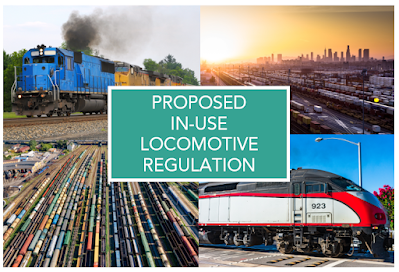Proposed In-Use Locomotive Regulation
September 21, 2022
The California Air Resources Board (CARB) has successfully
introduced several programs to transform California’s freight transportation
systems to reduce community impacts from the movement of people and freight.
However, there is still work to do as the freight transportation network
expands and locomotives remain a large contributor to poor air quality in the
state.
CARB is proposing the In-Use Locomotive Regulation to reduce
criteria pollutants, toxic air contaminants, and greenhouse gas emissions from
locomotives in-use. The proposed regulation is intended to be implemented
statewide
The goal of the proposed regulation is to accelerate
adoption of advanced cleaner technologies for all locomotive operations. As discussed in CARB’s draft 2022 State Strategy for the State Implementation Plan, zero-emission technologies are critical to
the State’s ability to protect public health, address climate change, and meet
both state and federal air quality standards.
We plan to take this important regulation for public health
to our Board for initial discussion November 17, 2022. This hearing will be the
first of two Board hearings, where the Board may give staff direction to modify
the proposal. This is an opportunity for all voices to be heard—those of community
members, members of the public, and regulated stakeholders. The Board hearing
will take place in-person at the CalEPA Headquarters and virtually via Zoom, a
web-based video conferencing service. Members of the public who wish to comment
verbally can register for the webinar at the link below.
https://ww2.arb.ca.gov/ma111722
Members of the public who wish to submit a written comment
on the proposal can do so at the link below.
https://ww2.arb.ca.gov/rulemaking/2022/locomotive
More background and the key elements of the proposed In-Use
Locomotive Regulation can be found in the Locomotive Regulation Factsheets on
the Reducing Rail Emissions in California Webpage.
Background: Locomotives contain the large engines that are
used to move railcars that together form a train. Locomotives travel throughout
the state to seaports, railyards, and other locations that are near where
people work and live. Current locomotive engines emit multiple air pollutants,
including diesel particulate matter, fine particulate matter (PM2.5), oxides of
nitrogen (NOx) and greenhouse gases (GHG). Exposure to toxic and harmful diesel
emissions is known to lead to cancer and increases in asthma, heart illness,
lung illness, hospitalizations, and premature death. Disadvantaged communities
are often more affected by these emissions because of their close proximity to
where locomotives are used most.
Because locomotives can move large amounts of freight using
less fuel than other modes of transport, they historically have been considered
one of the most efficient ways to move goods. However, beginning in 2023,
trucks will emit less air pollution than the average locomotives in use in
California, thanks to increasingly more stringent CARB truck regulations. Visit
the Draft Truck vs. Train Emissions Analysis webpage for more information.
To address air pollution from locomotives, CARB is proposing
the In-Use Locomotive Regulation. The proposed regulation would:
(1) Require locomotive operators to set aside money for cleaner locomotives and technology development
(2) Require by 2030 that locomotives operating in CA be less than 23 years old
(3) Have zero-emission requirements for locomotives operating in 2030 and later
(4) Require location-specific reporting of CA locomotive activity
(5) Give CARB the right to enforce the federal 30-minute idling limit
The proposed regulation encourages zero-emission technology
be used earlier than 2030 by giving credits to locomotive operators who do.
These credits can be used to decrease the amount of money they need to set
aside for cleaner locomotive development. If the operators use the
zero-emission technology in a disadvantaged community, they will receive double
the credit. The purpose is to incentivize locomotive operators to concentrate their
earliest zero-emission locomotive use within disadvantaged communities.
The regulation is expected to save Californians a total of
about $32 billion in health costs from avoided premature deaths,
hospitalizations, and emergency room visits.
